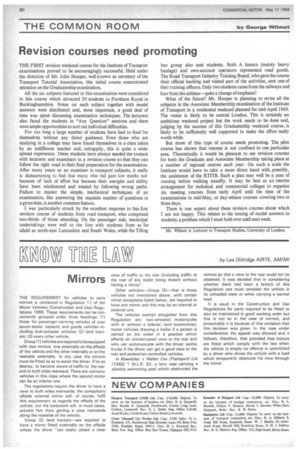EHam "IF
Page 82

If you've noticed an error in this article please click here to report it so we can fix it.
by Les Oldridge AIRTE, AM I MI
Mirrors
THE REQUIREMENT for vehicles to carry mirrors is contained in Regulation 17 of the Motor Vehicles (Construction and Use) Regulations 1966. These requirements can be conveniently grouped under three headings: (1) those for passenger-carrying vehicles of over seven-seater capacity and goods vehicles including dual-purpose vehicles; (2) land tractors; (31 every other vehicle.
Group (1) vehicles are required to be equipped with two mirrors, one externally on the offside of the vehicle and the other internally or on the nearside externally. In any case the mirrors most be fitted so as to assist the driver, if he so desires, to become aware of traffic to the rear and to both sides rearward. There are notmany vehicles in this class where the second mirror can be an interior one The regulations require the driver to have a view to both sides rearwards; the compulsory offside external mirror will, of course, fulfil this requirement as regards the offside of the vehicle, but the bodywork will, in most cases, prevent him from getting a view rearwards along the nearside of the vehicle.
Group (2) land tractors—are required to have a mirror fitted externally on the offside unless the driver "can easily obtain a clear view of traffic to the rear (including traffic to the rear of any trailer being drawn) without having a mirror".
Other vehicles—Group (3)—that is those vehicles not mentioned above, with certain minor exceptions listed below, are required to have one mirror and this may be an internal or external one.
The vehicles exempt altogether from this Regulation are: two-wheeled motorcycles with or without a sidecar; land locomotives; motor vehicles drawing a trailer if a person is carried on the trailer in a position which affords an uninterrupted view to the rear and who can communicate with the driver; works trucks if the driver can get a good view to the rear and pedestrian-controlled vehicles.
In Mawdsley v Walter Cox (Transport) Ltd. (1966) 1 W.L.R. 63, a lorry was carrying a plastics swimming pool which obstructed the mirrors so that a view to the rear could not be obtained. It was decided that in considering whether there had been a breach of this Regulation one must consider the vehicle in its unloaded state or when carrying a normal load.
It is usual in the Construction and Use Regulations for parts required to be fitted to also be maintained in good working order but this is not so in the case of mirrors, and presumably it is because of this omission that this decision was given. In the case under consideration the appeal was allowed and it follows, therefore, that provided that mirrors are fitted which comply with the law when the vehicle is empty no offence is committed by a driver who drives the vehicle with a load which temporarily obstructs his view through the mirror.




























































































































